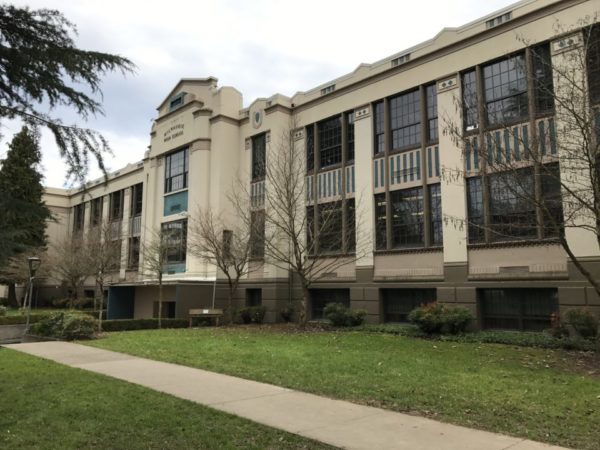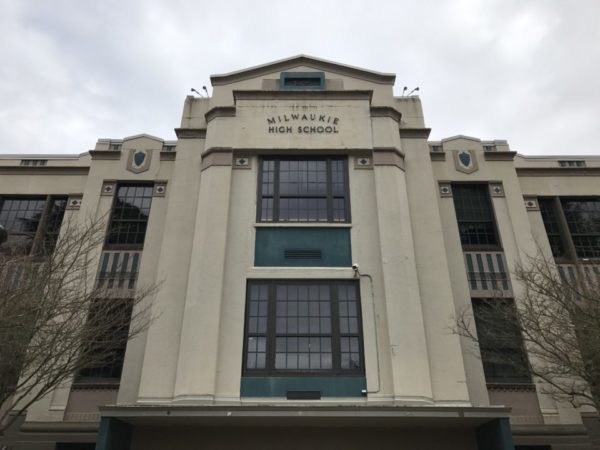 Annabella Gelmetti, a Milwaukie High School student, brings us her testimony which was delivered to a public meeting hosted by the North Clackamas School District regarding the proposed demolition of the Milwaukie High School. A bond measure was passed which could be used to renovate the school, but instead a new building is proposed. Built in 1925, the Milwaukie High School is listed in the City of Milwaukie’s Historic Resources Property List.
Annabella Gelmetti, a Milwaukie High School student, brings us her testimony which was delivered to a public meeting hosted by the North Clackamas School District regarding the proposed demolition of the Milwaukie High School. A bond measure was passed which could be used to renovate the school, but instead a new building is proposed. Built in 1925, the Milwaukie High School is listed in the City of Milwaukie’s Historic Resources Property List.
As said by Wayne Wood, founder of Riverside Avondale Preservation in Jacksonville Florida, Architecture is the most fragile of the arts, and is far less likely to survive than a poem or a symphony. “If you tear down a historic building, you have not only lost the historic value and the cultural value, but you have lost the material that it was made of and the energy that went into consuming it…If you demolish an average 2500 square foot American home you have totally obliterated all the environmental and economic benefits equivalent to 1m aluminum cans” (Wood).
I would like to say, in respect to cost, I find it incredibly hard to believe that tearing down this school and building a new one would be more financially doable than working with the infrastructure that we already have; and I would also like to say that, “You cannot build a historic building” (Wood). You can only preserve it, and so I suggest we preserve historic Milwaukie High School.
The first concern I seek to address is the environment. Donovan D. Rypkema Principal of the PlaceEconomics organization states that, “Historic preservation is the ultimate recycling strategy.”As an Oregonian, I can imagine that recycling . In several studies done by Donovan D. Rypkema, not only is the mechanical and human energy lost when demolishing historic structures, but the act of demolishing these structures releases many toxins and pollutants into the air of the community. In one particular study, The Economics of Historic Preservation: A Community Leader’s Guide, Rypkema found that the U.S. generates 31.5 tons of construction waste per year, which makes up approximately 24% of all solid waste created by the States. Certain beloved trees on campus may be uprooted, and through air toxins and pollutants, the demolition of this school will essentially lead to future environmental problems, and elevate the environmental issues we find ourselves, as a nation, currently struggling with.
“Rehabilitating historic properties conserves taxpayers’ dollars, conserves our local heritage, and conserves the natural environment. Rehabilitating historic buildings and using the infrastructure that is already in place to serve them is the height of fiscal and environmental responsibility” (Rypkema). It cannot be denied that energy is another dispute to be had when constructing a new building. Several studies done by LEED or Leadership in Energy and Environmental Design, with the U.S. Green Building Council, in terms of Energy, have pointed to the idea that older buildings in the 100 year old range tend to outperform newer buildings in energy efficiency. Mentioned in a discussion held by the LEED council, “The greenest buildings are the ones that are already built.”
 In an economic impact study through the State Historic Preservation Office of Connecticut, it was found that while rehabilitating a property now known as “The Hollander,” a historic building transformed into mixed income housing, had this property been raised instead, 615,777 gallons of gas in embodied energy would have been disposed of as well as the money put into it, 9,986 gallons of gas would have been used up, the demolition alone would be equal to approximately a month of garbage generated by the entire city of Hartford, Connecticut, the debris would fill 39 boxcars, and the benefits of 22 million recycled aluminum cans would have been wiped out.
In an economic impact study through the State Historic Preservation Office of Connecticut, it was found that while rehabilitating a property now known as “The Hollander,” a historic building transformed into mixed income housing, had this property been raised instead, 615,777 gallons of gas in embodied energy would have been disposed of as well as the money put into it, 9,986 gallons of gas would have been used up, the demolition alone would be equal to approximately a month of garbage generated by the entire city of Hartford, Connecticut, the debris would fill 39 boxcars, and the benefits of 22 million recycled aluminum cans would have been wiped out.
A valid argument I often hear is the concern for Milwaukie High’s earthquake instability, but preserving such a building is possible. I have witnessed century old structures in Europe, such as Castel San Pietro in Verona, Italy, which has been standing for 700 years and no doubt seen its share of earthquakes; 2000 years old, the Arena, a fully functioning theater, at some point stood on the brink of collapse, is still used frequently; and the Louvre, an architectural work of art, home to history that would be an unimaginable loss, should it no longer be standing. John F. Kennedy has walked the very halls of this school during his first campaign, which is something a new high school could not say. You cannot build a historic building.
Someone who is not often recognized for his appreciation of architecture is Napoleon Bonaparte. Napoleon was not the greatest man nor leader in history, but if he hadn’t saved France architecturally, the national archives would not have a home of their own, and the Louvre would not exist as it does today.
These kinds of buildings are important because they connect us to our local history and act as interactive history. If you have not been through Milwaukie High School, I strongly encourage you to visit our third floor and admire the craftsmanship that was once put into the very walls of our school: there you will find the ceilings that are covered in window blinds, hiding what should be skylights, and the crown molding that reminds me of France everyday I attend my math and science classes. Examine old photos of Milwaukie High and the gothic structure that once adorned the face of our beautiful school, and how bare it looks today, without its jewelry. Everyday, I see what reminds me of French architecture in this high school, I see the Louvre when I recognize the contrasts of the old and the new on campus, and in total, when I look at my high school, I see living, breathing art.
Milwaukie High School is not the Louvre, but as far as education goes, it is my Louvre.

